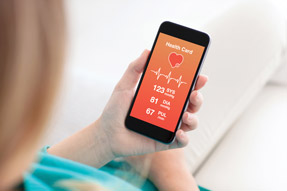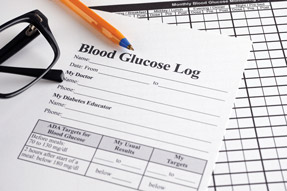Mobile apps no ‘magic pill’ for maintaining health
Health maintenance and lifestyle apps could reach a new generation of patients, but there are challenges that could limit their overall success.
Apple's pervasive catch phrase “There's an app for that” helped usher in the app craze, with its implication that mobile technology would leave no need or problem unmet. That unrealistic expectation has gone unrealized, and the world of apps—health and medical apps included—has entered a new stage. This may be where the real work begins.
The appeal of apps is not going away. Some 60,000 health or medical apps are available in the iTunes App Store, ranging from calorie counters to ICD-10 preparation guides. Statistics from the Pew Internet Project show that 64% of American adults owned smartphones as of 2014, up from 35% in 2011. Meanwhile, 62% of smartphone users have looked up some kind of health information in the past year.

The Pew Internet Project also reports that only 27% of the 65-plus population (typically the largest health care consumer group) currently owns a smartphone, but that's up 8 percentage points from just a year ago. Plus, given that most apps are free or only cost a few dollars apiece, those who can afford smartphones will probably not feel a financial burden from acquiring apps.
“Millennials were born with a smartphone in their hand. This is how we reach that population,” said Sameer Badlani, MD, FACP, chief health information officer for Intermountain Healthcare in Salt Lake City. “On the other side, baby boomers are not technophiles, but we underestimate their desire or ability to adopt [new technology].”
The technology exists to achieve a range of goals. For example, the uMotif app uses phone sensors to measure tremors while the patient holds the phone in the palm of his or her hand. Researchers also use this app to measure exercise levels as a way of exploring whether or to what extent exercise can slow or reverse the progression of Parkinson's disease.
But experts often note that the biggest potential for the mobile medical app may be for improving physician-patient communication and, in turn, patient adherence. Thus far, however, that breakthrough has proven elusive.
“It's similar to dieting. People give up [using health apps] after about 4 months,” Dr. Badlani said. “People are just not sticking to these apps. At first, everyone walked away thinking it was a magic pill. Just like everything, there's no one-off solution.”
A study published in 2014 in Annals of Internal Medicine found that when research assistants gave 105 primary care patients the MyFitnessPal app as a weight-loss aid, only 13% were still using it 6 months later. Although the app itself appeared to function well, it simply did not catalyze action in those not already inclined to act.
“Overall, providing the app to patients did not result in greater weight loss compared to the control group, but it does seem like a helpful tool for people who are motivated,” said Brian Yoshio Laing, MD, MPH, the lead study author and a primary care physician at the Martin Luther King Jr. Outpatient Center in Los Angeles. “For motivated people, there was a correlation between how often they used it and how much weight they lost.”
Sticking power
The study results highlight a key part of the ongoing app challenge: longevity. What's the secret to making an app not only work for physicians and patients but also keep them coming back over the long term? In tech circles, the concept is known as “stickiness,” and it's especially important in health care, where lifestyle changes take time and sustained effort.
“Once the novelty or the newness goes away, there has to be demonstrable value, not just to the physician but to the patient,” Dr. Badlani said. “What is the value-add for that particular app? What makes you download and keep using it?”
This may be where the physician's office can play a role. Rather than recommending apps wholesale, doctors and other team members can identify patients who seem ready to commit to a sustained push toward better health.
“Patient compliance is one of the biggest problems health care has,” said Bakul Patel, associate director for digital health at the FDA's Center for Devices and Radiological Health. “I think it's going to be gradual over time, but it comes back to physicians knowing how a patient does outside of a visit.”
One subcategory of apps that fit this description is known as mobile health or m-health apps. These kinds of apps can collect patient data on a given metric—weight, blood pressure, glucose values—and either transmit them to the doctor's office or store them for review at the next visit.
But which patients are receptive to protracted relationships with their smartphones? Often, patients who have recently gone through a major health event, such as a coronary artery bypass graft, are the most willing to listen to new approaches.
“Pick slices of patients who will have high activation levels,” Dr. Badlani advised. “Post-cardiac patients have high obedience and activation.”
But this may still not be enough. That's why more app developers (which include, in some cases, health care organizations) are integrating real people with technology.
“An app can gather data and provide regular interaction with a coach,” Dr. Badlani said. “Plain technology without the human touch is never going to succeed.”
When discussing apps with his own patients, Dr. Laing recommends Fooducate, a nutrition app that includes food information and a social discussion platform, and Argus, a similar app focusing on fitness. But the key to his recommendations, Dr. Laing said, is that he tried them and liked them himself.
“Get familiar with the apps, try them out, and then you can speak from experience when you're talking to patients,” Dr. Laing said.
New regulatory guidance
The FDA issued guidance in February to help physicians, device manufacturers, and others navigate the world of mobile medical apps and clarify where the administration plans to apply its authority.
In essence, according to Mr. Patel, who authored the guidance, the FDA will exercise authority over apps that transform a smartphone into a “medical device.”
“When the intended use of a mobile app is for the diagnosis of disease or other conditions, or the cure, mitigation, treatment, or prevention of disease, or is intended to affect the structure or any function of the body of man, the mobile app is a device,” the guidance states.
Examples of apps that could meet this category include those that remotely control other medical devices such as a blood pressure cuff, display patient-specific data, or have functionalities similar to existing devices. Many m-health apps could meet these criteria, although most apps on the market today do not, at least not to the extent that the FDA would exercise enforcement, Mr. Patel said.
“A lot of apps may not meet the definition of a medical device, so are not a part of the FDA's purview,” Mr. Patel said. “Others may be considered devices but are so low risk [in terms of FDA's device classification] and at the same time beneficial that they will not be the focus for FDA to enforce compliance to regulatory requirements. Apps that transform the smartphone into a medical device, or use a sensor of any kind to transform, will be the types of apps FDA intends to actively oversee.”
Mr. Patel, who added that FDA officials will “continue to clarify our position and our regulations,” suggested that these kinds of apps, which serve to aid in direct care and treatment, are a key part of the future of health technology.
“I think from our perspective, apps are going to be great tools for the physician to use,” Mr. Patel said. “It's going to help physicians be more cognizant of how patients are behaving, reacting, and complying. The potential for compliance in patients is going higher, and that will make a physician's life easier.”
What lies ahead
In the coming years, experts predicted, the field will narrow for medical apps, while doctors and other professionals take a closer look at their clinical needs—and the needs of each individual patient—before making concrete recommendations to those they care for.
“What many [providers] are moving toward are curating apps that are both physician-facing and patient-facing and then recommending things,” Dr. Badlani said, noting that they must be recommended on a case-by-case basis. He also said that apps can be an extender of a practice. “Take time to learn and adopt new technologies. Don't just take it as business as usual. Change your workflows to adapt,” he advised.
Devices only just beginning to breach the mainstream may be commonplace 5 years from now, moving closer to the goal of truly personalized health, and a stronger connection between clinicians and consumers, Dr. Badlani said.
“This is opening up conversations that look at patient engagement and a patient's ownership of their own care that we weren't having before,” he noted. “It has opened up tremendous opportunity.”



